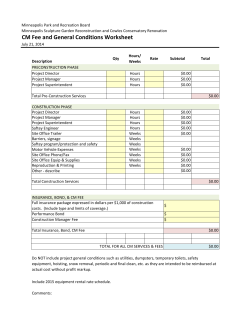
6) Should measures be taken to promote greater liquidity in
6) Should measures be taken to promote greater liquidity in corporate bond markets, such as standardisation? If so, which measures are needed and can these be achieved by the market, or is regulatory action needed? There is an ongoing debate about the nature and extent of possible liquidity problems in European corporate bond markets. In general the UK is supportive of measures that promote vibrant primary and secondary markets, though we do not believe there are any “quick wins” in this area. The UK has three recommendations for further action and we have explored some the issues of liquidity and standardisation in more detail at the end of the response to this question. 1. The Commission should undertake a root-and-branch study into the EU’s corporate bond markets. The Commission should seek to identify the nature and extent of liquidity problems in the various forms of European corporate bond markets to build a knowledge base which would inform all subsequent policy interventions. This should examine the nature of bond market issuance and demand to see if lessons can be learned from other jurisdictions that have a more active corporate bond market as well as seeking potential lessons from other, more liquid markets. The review should also consider the merits of all-to-all electronic trading networks which some have highlighted as a potential solution to current liquidity problems. By enabling investors as well as intermediaries to trade with each other, the pool of potential buyers and sellers can be more efficiently navigated. These nascent networks are increasing in activity and scale, their progress should be monitored, encouraged, and action considered if barriers emerge to hinder their activities. It should be recognised however that such networks are only one element of a range of potential solutions which the study may recommend as well as being a part of the overall mix of trading methods that may be employed by investors including RFQ and voice-driven trading. 2. Ensure MiFID II pre-trade transparency requirements are appropriately calibrated. ESMA are currently working on level two measures for MiFID II to help increase both pre and post trade transparency of non-equity markets including corporate bonds. Given the delicate state of liquidity in this market, ESMA should take a sensitive approach when developing these measures. This should be achieved by introducing new requirements very carefully, closely following the level 1 provisions. First, this means that significant care must be taken to accurately identify the liquid instruments for which the full transparency requirements should apply. Secondly, there should be careful assessment before imposing requirements to make market positions public where such obligations could give rise to undue risk for market makers that would in turn damage liquidity. Where there is uncertainty on these points ESMA should look to calibrate their initial regime cautiously, with a view to reviewing the precise thresholds as markets evolve. 3) The Commission should carefully consider the arguments for and against standardisation. There are range of views around the possible merits of standardisation. While the UK understands there is substantial industry scepticism, particularly regarding limits on maturity dates and prescribed issue sizes, some are supportive of some elements of standardisation. Issue terminology and documentation are two examples that fall into this latter category. The UK has not yet considered these issues in sufficient detail to come to a proprietary view regarding this point. Further discussion of liquidity: Comparisons are often drawn between the EU and US markets. The annual level of issuance of non-financial corporate bonds in Europe has only exceeded that of the US once, in 2009. The US market regained its issuance lead in 2010 and has retained it ever since, seeing USD 739 bn in 2013 vs Europe’s USD 593 bn (Dealogic, Deutsche Bank), about 30% more when expressed as a percentage of GDP, 4.4% vs 3.4% using IMF GDP data. The disparity is even more marked when looking at the total liabilities of non-financial corporations, with debt securities accounting for 20% of European liabilities against more than 80% for the US (ECB, Federal Reserve, Deutsche Bank). Differences between EU and US markets are driven by a combination of structural and cultural issues, such as investor attitude, an active municipal market in the US, and a liquid zero-coupon Government market aimed at investors saving for particular life events such as tuition fees. Given the post-crash constraints upon bank balance sheets and risk appetite it is likely that Europe may need to utilise debt securities more than it has previously if business is to find the capital needed to provide the required level of growth in Europe. Before we can establish whether interventions in the bond markets are needed, it is necessary to establish whether there is a genuine problem with regard to liquidity. There are concerns amongst market participants, particularly on the buyside, about the decline in liquidity available in corporate bond markets. The Bank for International Settlements’ (BIS) Committee on the Global Financial System (CGFS) November 2014 report examined this question in detail and found that the supply of liquidity in Europe has substantially fallen following the global financial crisis. As an example, the major banks’ gross and net trading securities positions in 2013 were less than half those in 2007. This measure indicates the banks’ ability to warehouse fixed income risk and therefore their capacity as market makers has significantly reduced since the financial crisis. In the future the supply of liquidity may get worse as bond markets react to changes in interest rates. Demand for corporate bonds in Europe has dramatically increased as interest rates have fallen, evidenced by the substantial drop in corporate bond spreads shown in a chart of Euro investment grade bond spreads (see figure 1). The chart shows how the cost of corporate borrowing has fallen with relation to bank funding costs. Corporate bonds are currently trading at a significant premium, which may lead to a serious dislocation in the bond markets when interest rates finally rise, causing bond prices to fall. This may be compounded by investment banks who, having reduced their risk taking capacity, would find it difficult to provide the liquidity the bond market needs to function effectively. Additionally the CGFS found that corporate bonds were increasingly being bought and held rather than traded. Whilst it could be argued that this is a positive effect, leading to greater investor stability, it is may also lead to a reduction in the level of liquidity available. In the US corporate bond market (equivalent data for European markets isn’t available) the proportion of issues where at least half of the outstanding issue has changed hands in the previous year (a widely accepted indicator of liquidity and activity) has fallen by more than three quarters since 2007 to less than 5% by the end of 2013. We recommend the Commission explores these issues further in a root and branch review of corporate bond markets. Standardisation Standardisation of bond maturity dates (the IMM quarterly dates have been suggested) and coupon rates have been proposed as a possible solution to the liquidity problem together with the use of tap issues (re-opening existing bonds for issuance when seeking new capital from the market) of existing bonds. This would create fewer, larger bonds in an attempt to increase liquidity. The ideas have merit but can have unintended consequences as well as a potentially negative effect upon issuers as their freedom to match bond issuance with their cash flow and funding requirements is curtailed. One possible consequence is the effect upon investors of investing in tap issues with off-market coupons i.e. at a price some way from par. The difference between par and issue price may cause problems with accounting losses and capital gains tax in different jurisdictions thus potentially limiting the size of the investor pool and increasing the cost of issuance to the corporate borrower.
© Copyright 2025












![Discipline: [eine der fünf Kernfächer] - BDPEMS - Hu](http://cdn1.abcdocz.com/store/data/001705903_1-ba4b64300c19963b7c102799089aed92-250x500.png)